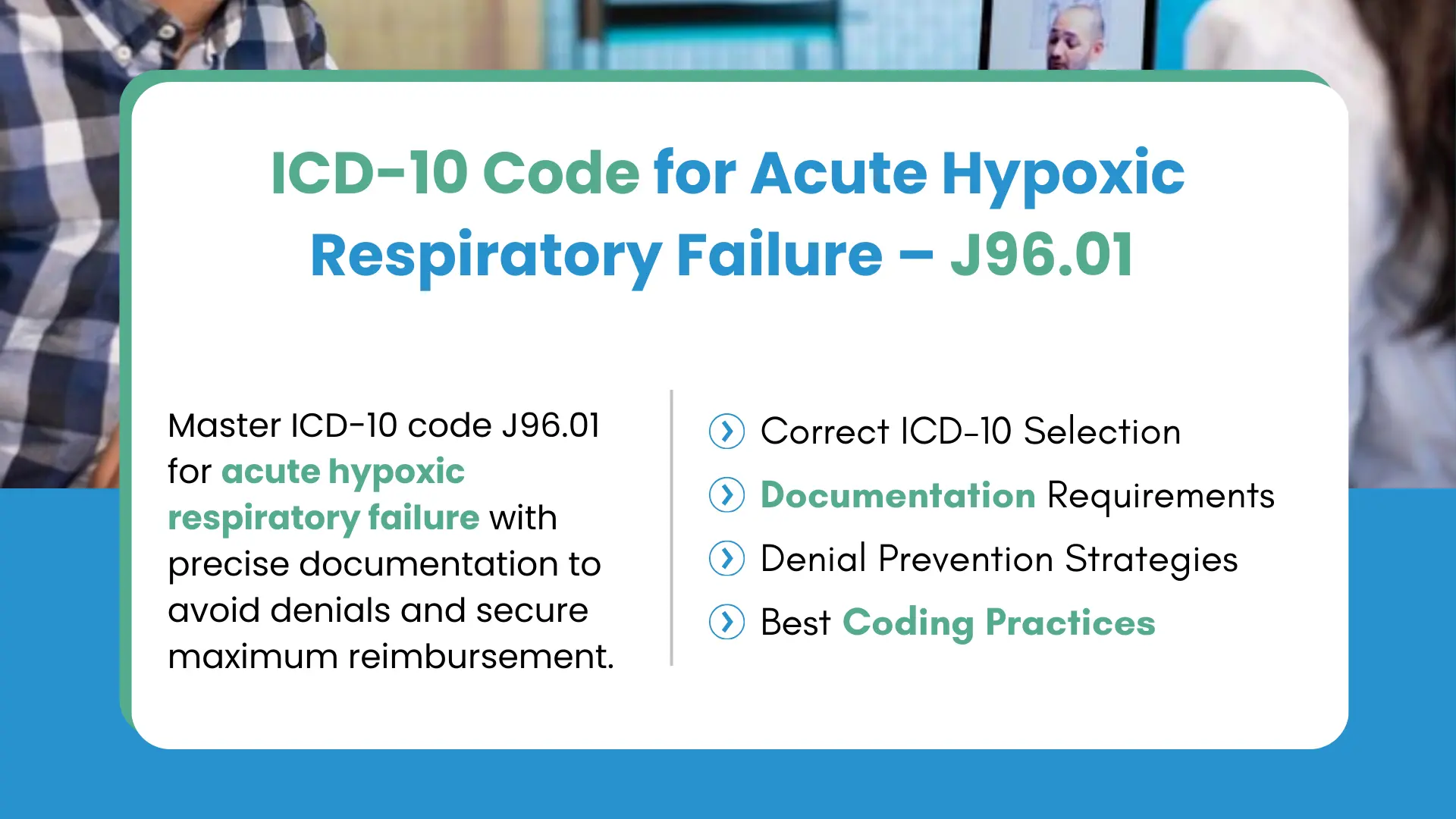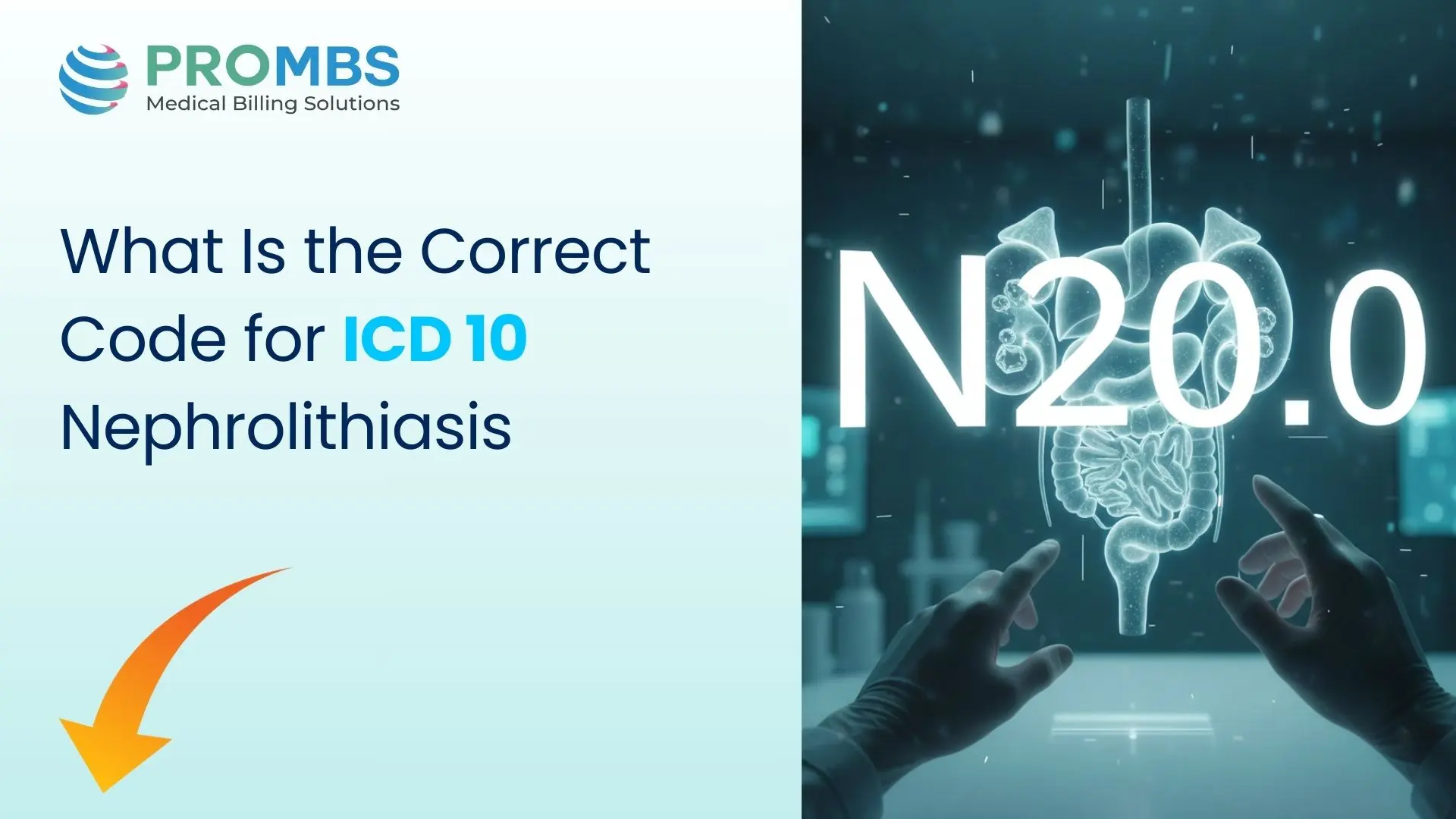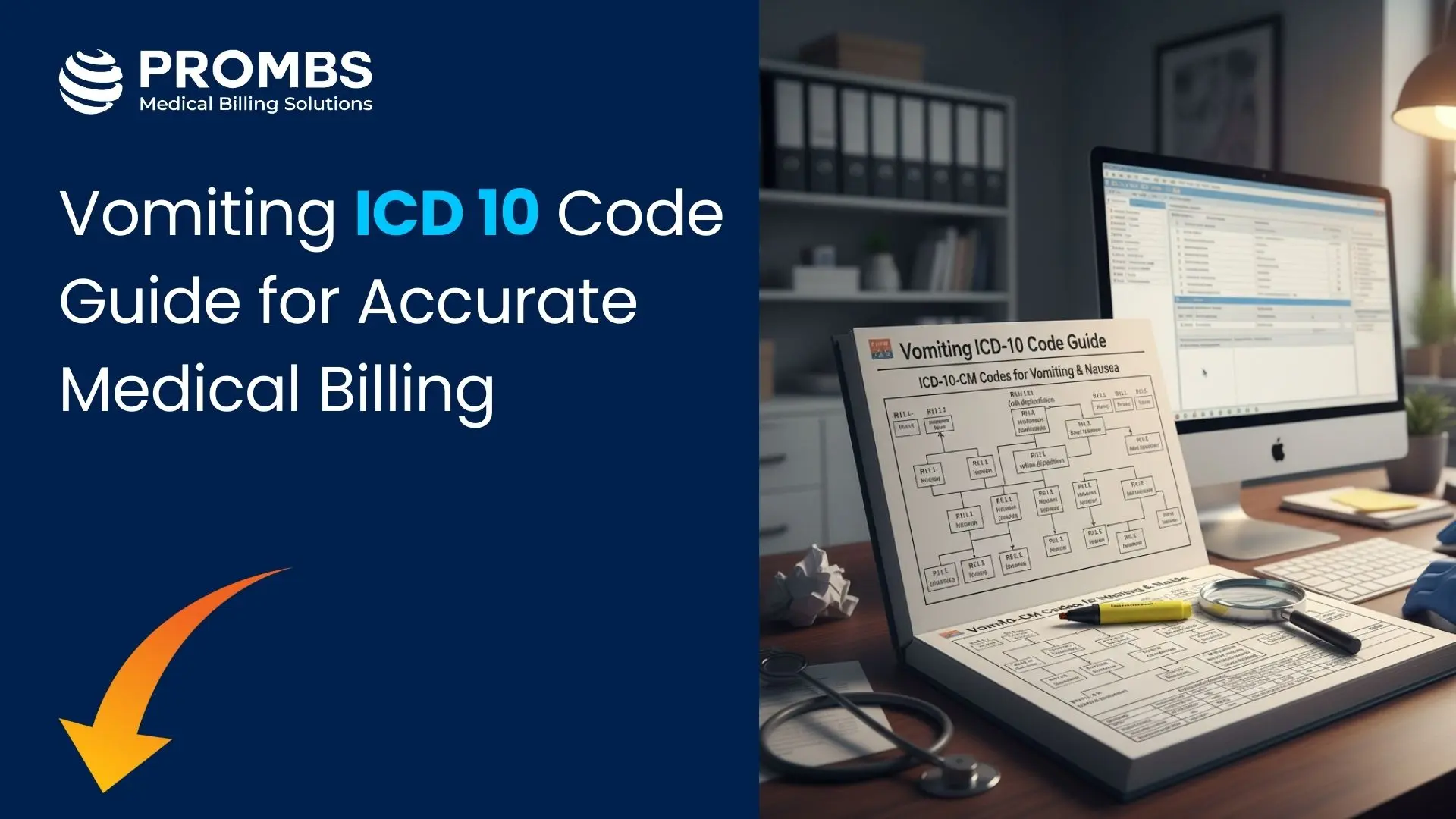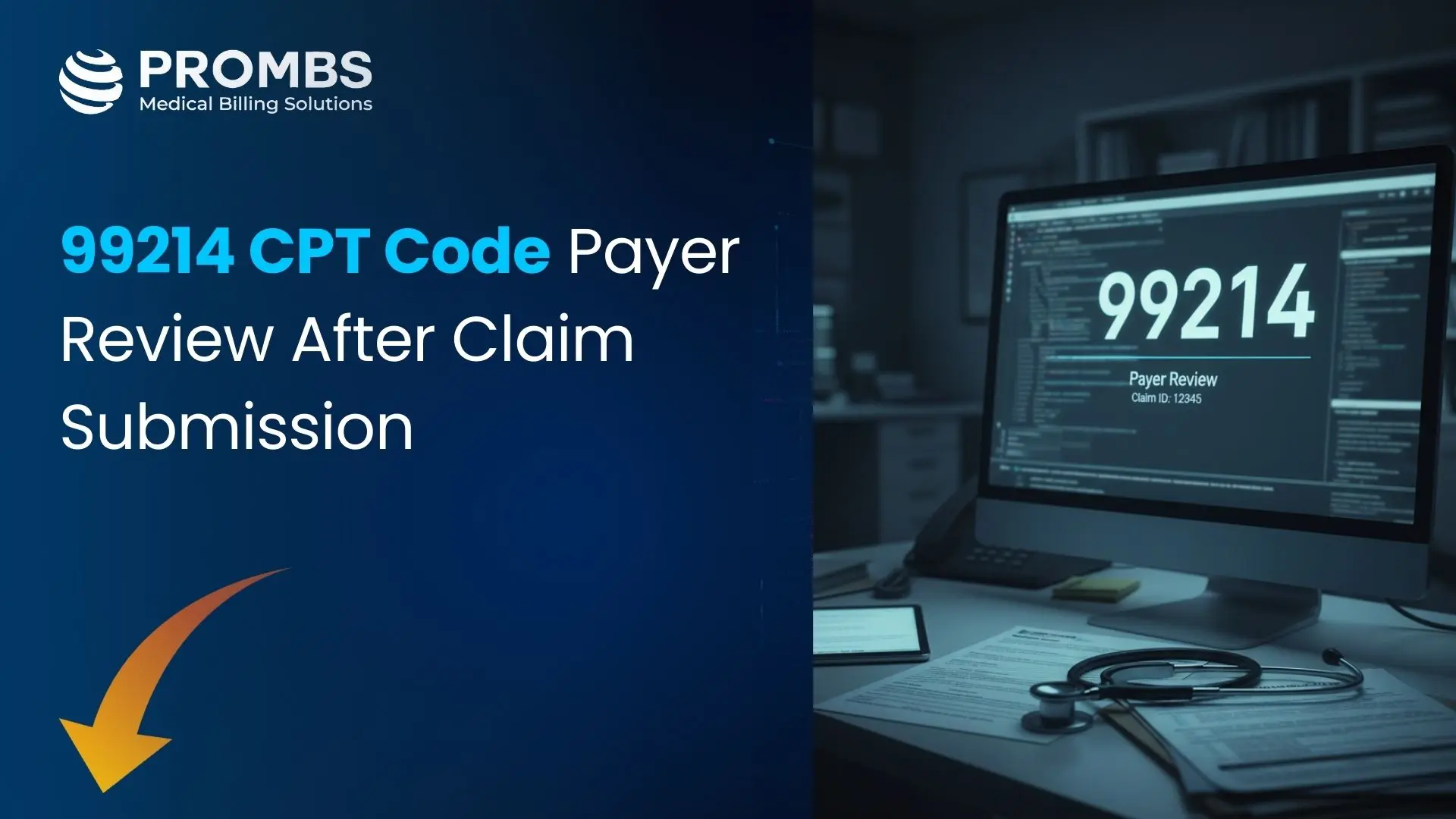Acute hypoxic respiratory failure is a critical, high-acuity condition in which the lungs fail to oxygenate blood adequately, leading to dangerously low oxygen levels (hypoxemia) in body tissues. It is frequently associated with conditions such as pneumonia, acute respiratory distress syndrome (ARDS), pulmonary embolism, or exacerbations of chronic lung diseases.
In medical billing and coding, the ICD-10 code for acute hypoxic respiratory failure is more than a diagnostic label, it determines DRG assignment, reimbursement levels, and compliance status. This is a high-scrutiny diagnosis in payer audits, making precision in code selection and documentation not just recommended, but essential.
Why ICD-10 Codes Get Denied (Respiratory Failure Cases)
Respiratory failure claims are among the most commonly denied in inpatient and ED settings due to incomplete or conflicting documentation. Denials usually stem from:
- Lack of clinical indicators: Missing arterial blood gas (ABG) results, SpO₂ readings, or other objective evidence of hypoxemia.
- Non-specific coding: Using J96.00 (acute respiratory failure, unspecified) when the documentation supports a more specific code such as J96.01.
- Conflicting documentation: Physician notes stating “respiratory distress” while nursing or RT notes document normal oxygen saturation.
- Sequencing errors: Assigning acute respiratory failure as principal diagnosis when another condition was the primary reason for admission.
- Impact: Such errors can cause DRG downgrades, revenue loss, and trigger payer audits that may lead to retroactive recoupments.
What Is the ICD-10 Code for Acute Hypoxic Respiratory Failure?
The primary billable code is:
J96.01 – Acute respiratory failure with hypoxia
- Billable & Specific: This code is valid for HIPAA-covered transactions and represents acute onset respiratory failure characterized by hypoxia.
- Clinical Definition: PaO₂ < 60 mmHg on ABG analysis or oxygen saturation SpO₂: ≤ 90% on room air, with clinical signs such as tachypnea, use of accessory respiratory muscles, and cyanosis.
- Key Coding Requirement: Documentation must explicitly state “acute respiratory failure with hypoxia” or “acute hypoxic respiratory failure” along with supportive clinical indicators.
When to Use This Code
The ICD-10 code for acute hypoxic respiratory failure (J96.01) is assigned when all of the following are met:
- The condition is acute in onset (sudden decompensation).
- The hypoxia is confirmed by ABG or SpO₂ measurements.
- The diagnosis is explicitly documented by the provider as “acute hypoxic” or “acute respiratory failure with hypoxia.”
- The presentation is not an acute-on-chronic episode unless specifically documented (in which case J96.21 applies).
Principal vs. Secondary Diagnosis
Principal diagnosis if acute hypoxic respiratory failure is the main reason for admission and is the primary condition treated.
Secondary diagnosis if it develops after admission or is a complication of another condition.
COVID-19 sequencing rule: If acute respiratory failure is due to COVID-19 and COVID-19 is the primary reason for the encounter, assign U07.1 (COVID-19) as the principal diagnosis and J96.0- (specific type of acute respiratory failure) as secondary, following ICD-10-CM and CDC guidelines. This scenario is frequently audited, so ensure the linkage is clearly documented in the provider’s notes.
Other Billable Types of Respiratory Failure Codes
Note: While the ICD-10-CM title uses “with hypoxia,” many providers document “acute hypoxic respiratory failure.” This terminology is acceptable and maps directly to J96.01 as long as it is explicitly stated in the record.
| ICD-10 Code | Description | Common Use Case |
|---|---|---|
| J96.00 | Acute respiratory failure, unspecified whether with hypoxia or hypercapnia | When documentation does not specify hypoxia or hypercapnia. |
| J96.02 | Acute respiratory failure with hypercapnia | Acute failure driven by documented hypercapnia, as supported by clinical evaluation and test results. |
| J96.21 | Acute and chronic respiratory failure with hypoxia | For acute decompensation in a patient with established chronic hypoxic respiratory failure (e.g., COPD on home O₂). |
| J96.22 | Acute and chronic respiratory failure with hypercapnia | Acute-on-chronic hypercapnic failure, often in advanced COPD or obesity hypoventilation syndrome. |
Note – Excludes1 for J96.*
ICD-10-CM ALERT – “Excludes1” for J96.*
Rule: Never code together for the same encounter.
Per AAPC and ICD-10-CM guidelines, J96.* codes have an Excludes1 note for:
🔹 J80 – Acute respiratory distress syndrome (ARDS)
🔹 J95.82 – Postprocedural respiratory failure
🔹 R09.2 – Respiratory arrest
What this means:
If one of these diagnoses is documented, code it instead of the J96.* code not in addition to it.
💡 Example:
If the patient has ARDS (J80) documented, do not assign J96.01 for acute hypoxic respiratory failure. ARDS is a more specific diagnosis that already implies severe respiratory compromise, so coding both is duplicative and non-compliant.
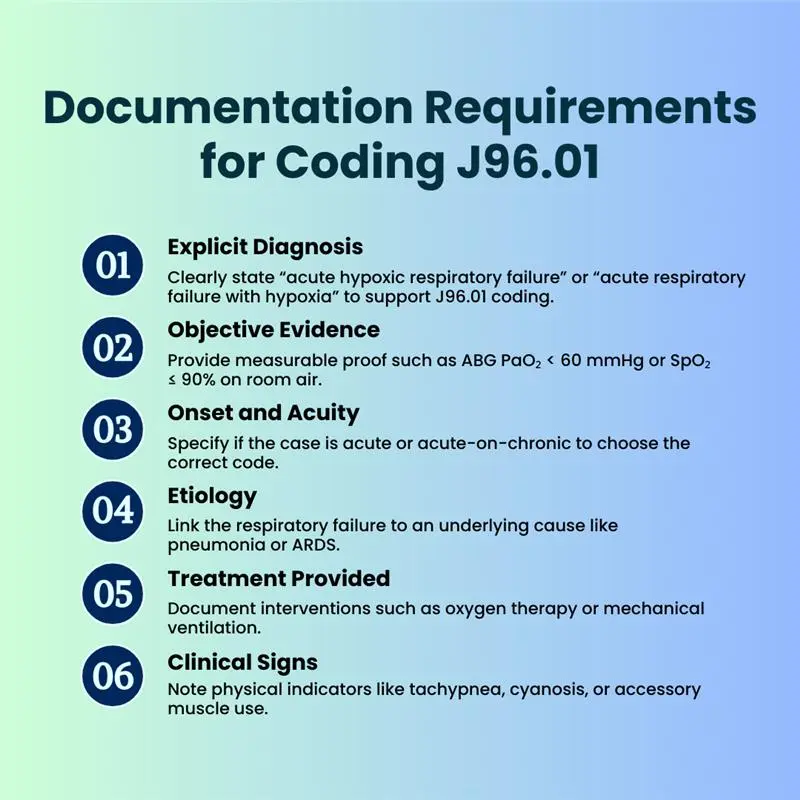
Documentation Requirements for Coding J96.01
Explicit Diagnosis
Objective Evidence
Objective evidence such as ABG PaO₂ < 60 mmHg or SpO₂ ≤ 90% on room air supports the diagnosis and medical necessity, but the provider’s explicit statement of “acute hypoxic respiratory failure” is sufficient for ICD-10 code assignment.
- ABG (PaO₂ < 60 mmHg) – An arterial blood gas test showing oxygen pressure in the blood is below the clinical threshold for hypoxemia.
- SpO₂ (< 90% on room air) – Pulse oximeter reading showing low oxygen saturation without supplemental oxygen. Payers expect this data to substantiate the diagnosis.
Onset and Acuity
Etiology
The record should connect the respiratory failure to its underlying cause, such as pneumonia, acute respiratory distress syndrome (ARDS), or congestive heart failure (CHF). Linking the cause strengthens medical necessity and coding accuracy.
Treatment Provided
Clinical Signs
Describing observable symptoms elevated respiratory rate, cyanosis (bluish skin), use of accessory muscles to breathe, or altered mental status due to hypoxemia provides further clinical justification for the diagnosis.
Best Practices for Accurate Coding
Use a Clinical + Coding Decision Framework
What it means: Have a structured checklist or EHR (electronic health record) prompt that forces the coder or provider to confirm whether the respiratory failure is hypoxic (low oxygen), hypercapnic (high CO₂), or both before choosing a code.
Why it matters: This ensures you’re picking J96.01 for hypoxia, J96.02 for hypercapnia, or the combined code when both are present rather than defaulting to the vague J96.00.
Benefit: Improves code specificity, which impacts DRG weight and reimbursement.
Code Both Hypoxia and Hypercapnia When Documented
What it means: If the provider documents acute respiratory failure with both hypoxia and hypercapnia, there is no single combined acute ICD-10 code. Assign J96.01 (with hypoxia) and J96.02 (with hypercapnia) when both conditions are clinically supported.
Why it matters: Per CDI and coding guidance (e.g., ACDIS.org), both codes may be reported together if fully supported in the documentation, as they describe distinct physiologic abnormalities.
Benefit: Accurately reflects severity, improves data integrity, and can impact DRG assignment.
Provider Education
What it means: Train doctors to always document the type of respiratory failure and the supporting evidence (ABG, SpO₂, clinical signs) in their notes.
Why it matters: If they just write “acute respiratory failure,” the coder might be forced to use an unspecified code, which lowers reimbursement and can cause denials.
Benefit: Eliminates ambiguity and makes coding defensible during audits.
Internal Audits
What it means: Review all cases where J96.00 (unspecified) was assigned to see if the records actually had enough detail to use a more specific code.
Why it matters: Sometimes the data is in the chart but wasn’t captured in coding. Regular review catches those missed opportunities.
Benefit: Boosts reimbursement accuracy and reduces compliance risk.
Sequence Appropriately
What it means: Follow UHDDS (Uniform Hospital Discharge Data Set) rules to decide if respiratory failure should be the principal diagnosis (the main reason for admission) or a secondary diagnosis (developed later or secondary to another condition).
Why it matters: Incorrect sequencing can change the DRG and payment, or lead to denial if payers believe the primary reason for admission was different.
Benefit: Keeps claims aligned with official coding guidelines and prevents financial disputes.
Align with Ancillary Documentation
What it means: Check that physician documentation matches other parts of the medical record like respiratory therapy logs, nursing notes, and ED triage assessments.
Why it matters: If a doctor documents “acute hypoxic respiratory failure” but nursing notes show normal oxygen saturation, it creates a red flag for auditors.
Benefit: Prevents contradictions that can trigger claim denials or allegations of upcoding.
